engine CHEVROLET KODIAK 2005 User Guide
[x] Cancel search | Manufacturer: CHEVROLET, Model Year: 2005, Model line: KODIAK, Model: CHEVROLET KODIAK 2005Pages: 374, PDF Size: 5.46 MB
Page 85 of 374
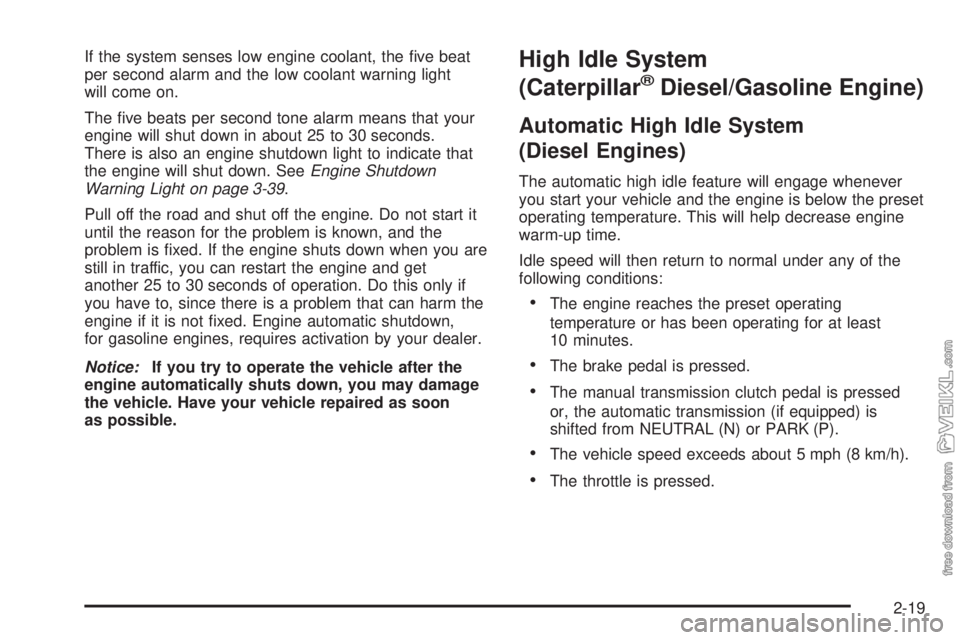
If the system senses low engine coolant, the five beat
per second alarm and the low coolant warning light
will come on.
The five beats per second tone alarm means that your
engine will shut down in about 25 to 30 seconds.
There is also an engine shutdown light to indicate that
the engine will shut down. SeeEngine Shutdown
Warning Light on page 3-39.
Pull off the road and shut off the engine. Do not start it
until the reason for the problem is known, and the
problem is fixed. If the engine shuts down when you are
still in traffic, you can restart the engine and get
another 25 to 30 seconds of operation. Do this only if
you have to, since there is a problem that can harm the
engine if it is not fixed. Engine automatic shutdown,
for gasoline engines, requires activation by your dealer.
Notice:If you try to operate the vehicle after the
engine automatically shuts down, you may damage
the vehicle. Have your vehicle repaired as soon
as possible.High Idle System
(Caterpillar
®Diesel/Gasoline Engine)
Automatic High Idle System
(Diesel Engines)
The automatic high idle feature will engage whenever
you start your vehicle and the engine is below the preset
operating temperature. This will help decrease engine
warm-up time.
Idle speed will then return to normal under any of the
following conditions:
•The engine reaches the preset operating
temperature or has been operating for at least
10 minutes.
•The brake pedal is pressed.
•The manual transmission clutch pedal is pressed
or, the automatic transmission (if equipped) is
shifted from NEUTRAL (N) or PARK (P).
•The vehicle speed exceeds about 5 mph (8 km/h).
•The throttle is pressed.
2-19
Page 86 of 374
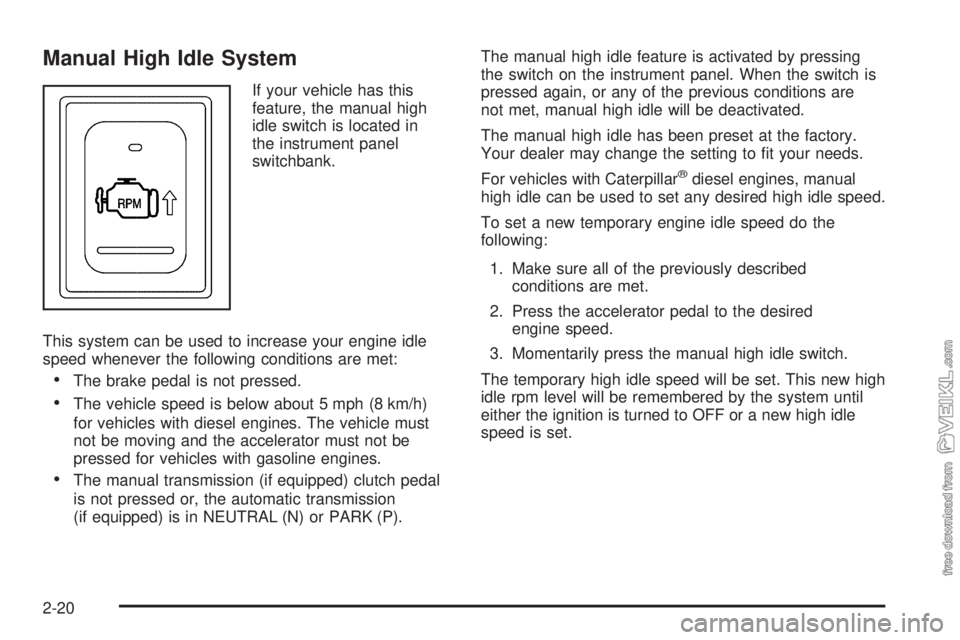
Manual High Idle System
If your vehicle has this
feature, the manual high
idle switch is located in
the instrument panel
switchbank.
This system can be used to increase your engine idle
speed whenever the following conditions are met:
•The brake pedal is not pressed.
•The vehicle speed is below about 5 mph (8 km/h)
for vehicles with diesel engines. The vehicle must
not be moving and the accelerator must not be
pressed for vehicles with gasoline engines.
•The manual transmission (if equipped) clutch pedal
is not pressed or, the automatic transmission
(if equipped) is in NEUTRAL (N) or PARK (P).The manual high idle feature is activated by pressing
the switch on the instrument panel. When the switch is
pressed again, or any of the previous conditions are
not met, manual high idle will be deactivated.
The manual high idle has been preset at the factory.
Your dealer may change the setting to fit your needs.
For vehicles with Caterpillar
®diesel engines, manual
high idle can be used to set any desired high idle speed.
To set a new temporary engine idle speed do the
following:
1. Make sure all of the previously described
conditions are met.
2. Press the accelerator pedal to the desired
engine speed.
3. Momentarily press the manual high idle switch.
The temporary high idle speed will be set. This new high
idle rpm level will be remembered by the system until
either the ignition is turned to OFF or a new high idle
speed is set.
2-20
Page 87 of 374
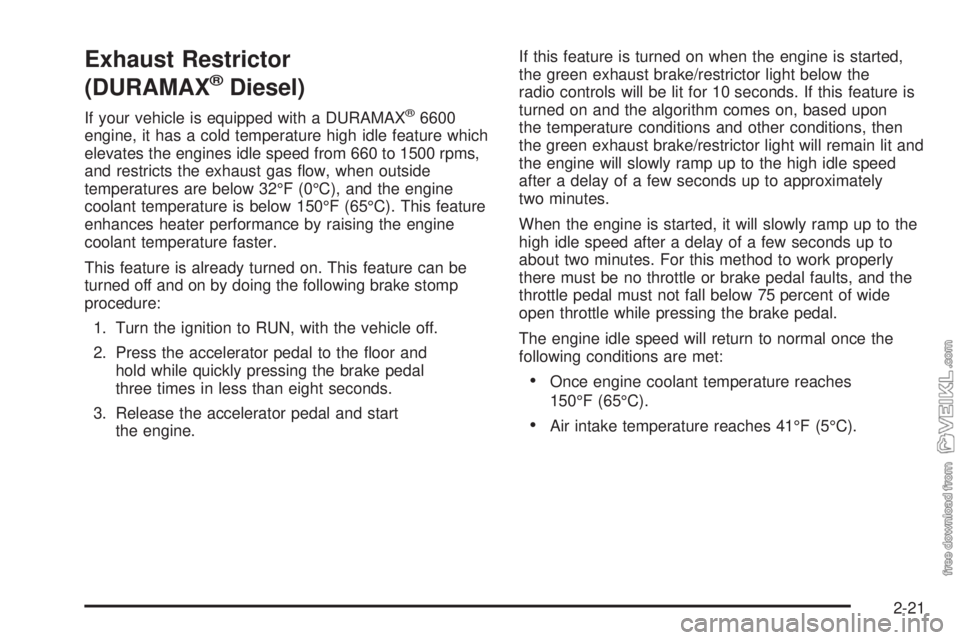
Exhaust Restrictor
(DURAMAX
®Diesel)
If your vehicle is equipped with a DURAMAX®6600
engine, it has a cold temperature high idle feature which
elevates the engines idle speed from 660 to 1500 rpms,
and restricts the exhaust gas flow, when outside
temperatures are below 32°F (0°C), and the engine
coolant temperature is below 150°F (65°C). This feature
enhances heater performance by raising the engine
coolant temperature faster.
This feature is already turned on. This feature can be
turned off and on by doing the following brake stomp
procedure:
1. Turn the ignition to RUN, with the vehicle off.
2. Press the accelerator pedal to the floor and
hold while quickly pressing the brake pedal
three times in less than eight seconds.
3. Release the accelerator pedal and start
the engine.If this feature is turned on when the engine is started,
the green exhaust brake/restrictor light below the
radio controls will be lit for 10 seconds. If this feature is
turned on and the algorithm comes on, based upon
the temperature conditions and other conditions, then
the green exhaust brake/restrictor light will remain lit and
the engine will slowly ramp up to the high idle speed
after a delay of a few seconds up to approximately
two minutes.
When the engine is started, it will slowly ramp up to the
high idle speed after a delay of a few seconds up to
about two minutes. For this method to work properly
there must be no throttle or brake pedal faults, and the
throttle pedal must not fall below 75 percent of wide
open throttle while pressing the brake pedal.
The engine idle speed will return to normal once the
following conditions are met:
•Once engine coolant temperature reaches
150°F (65°C).
•Air intake temperature reaches 41°F (5°C).
2-21
Page 88 of 374
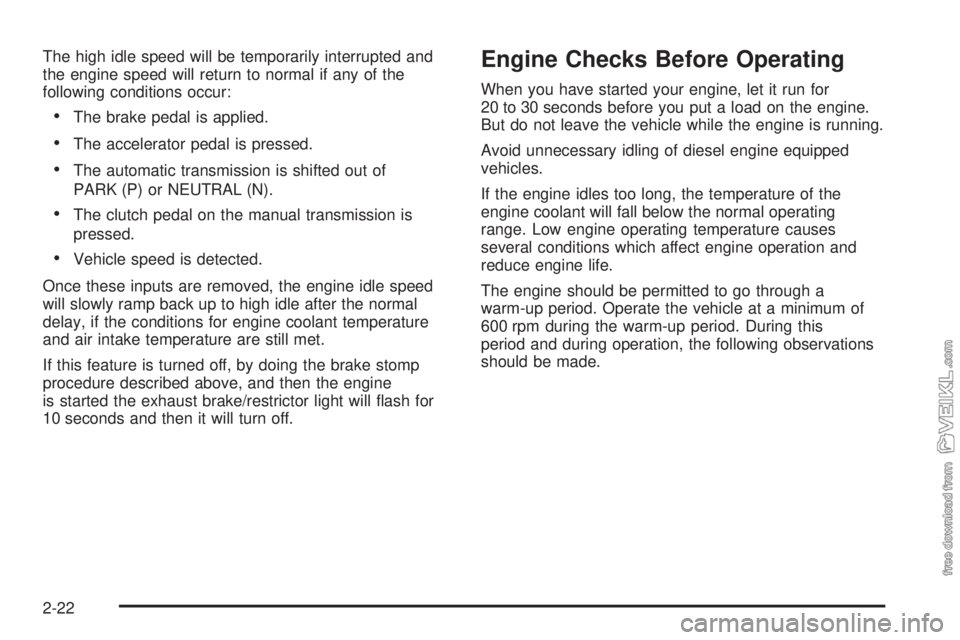
The high idle speed will be temporarily interrupted and
the engine speed will return to normal if any of the
following conditions occur:
•The brake pedal is applied.
•The accelerator pedal is pressed.
•The automatic transmission is shifted out of
PARK (P) or NEUTRAL (N).
•The clutch pedal on the manual transmission is
pressed.
•Vehicle speed is detected.
Once these inputs are removed, the engine idle speed
will slowly ramp back up to high idle after the normal
delay, if the conditions for engine coolant temperature
and air intake temperature are still met.
If this feature is turned off, by doing the brake stomp
procedure described above, and then the engine
is started the exhaust brake/restrictor light will flash for
10 seconds and then it will turn off.
Engine Checks Before Operating
When you have started your engine, let it run for
20 to 30 seconds before you put a load on the engine.
But do not leave the vehicle while the engine is running.
Avoid unnecessary idling of diesel engine equipped
vehicles.
If the engine idles too long, the temperature of the
engine coolant will fall below the normal operating
range. Low engine operating temperature causes
several conditions which affect engine operation and
reduce engine life.
The engine should be permitted to go through a
warm-up period. Operate the vehicle at a minimum of
600 rpm during the warm-up period. During this
period and during operation, the following observations
should be made.
2-22
Page 89 of 374
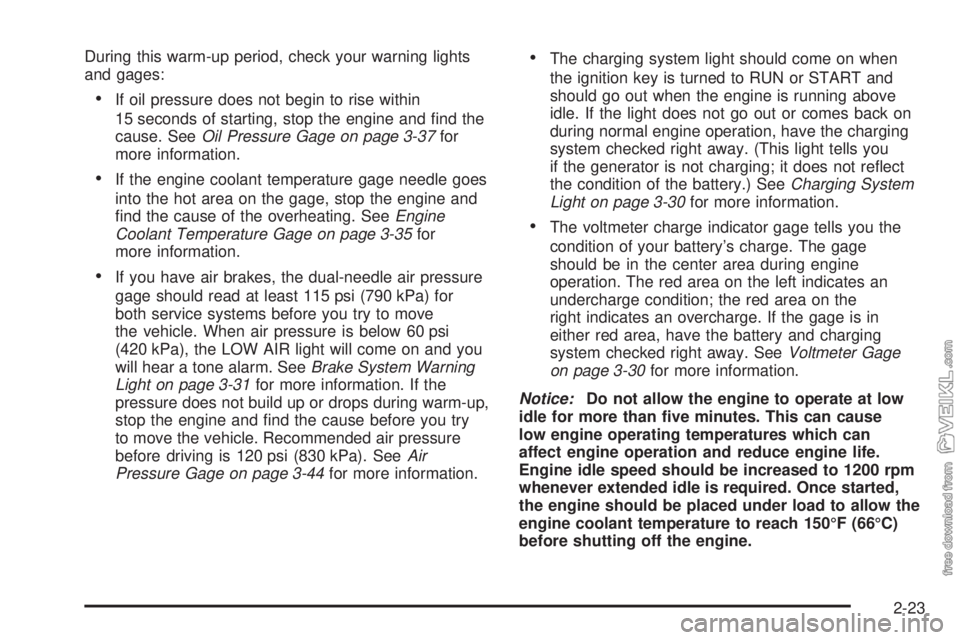
During this warm-up period, check your warning lights
and gages:
•If oil pressure does not begin to rise within
15 seconds of starting, stop the engine and find the
cause. SeeOil Pressure Gage on page 3-37for
more information.
•If the engine coolant temperature gage needle goes
into the hot area on the gage, stop the engine and
find the cause of the overheating. SeeEngine
Coolant Temperature Gage on page 3-35for
more information.
•If you have air brakes, the dual-needle air pressure
gage should read at least 115 psi (790 kPa) for
both service systems before you try to move
the vehicle. When air pressure is below 60 psi
(420 kPa), the LOW AIR light will come on and you
will hear a tone alarm. SeeBrake System Warning
Light on page 3-31for more information. If the
pressure does not build up or drops during warm-up,
stop the engine and find the cause before you try
to move the vehicle. Recommended air pressure
before driving is 120 psi (830 kPa). SeeAir
Pressure Gage on page 3-44for more information.
•The charging system light should come on when
the ignition key is turned to RUN or START and
should go out when the engine is running above
idle. If the light does not go out or comes back on
during normal engine operation, have the charging
system checked right away. (This light tells you
if the generator is not charging; it does not reflect
the condition of the battery.) SeeCharging System
Light on page 3-30for more information.
•The voltmeter charge indicator gage tells you the
condition of your battery’s charge. The gage
should be in the center area during engine
operation. The red area on the left indicates an
undercharge condition; the red area on the
right indicates an overcharge. If the gage is in
either red area, have the battery and charging
system checked right away. SeeVoltmeter Gage
on page 3-30for more information.
Notice:Do not allow the engine to operate at low
idle for more than �ve minutes. This can cause
low engine operating temperatures which can
affect engine operation and reduce engine life.
Engine idle speed should be increased to 1200 rpm
whenever extended idle is required. Once started,
the engine should be placed under load to allow the
engine coolant temperature to reach 150°F (66°C)
before shutting off the engine.
2-23
Page 90 of 374
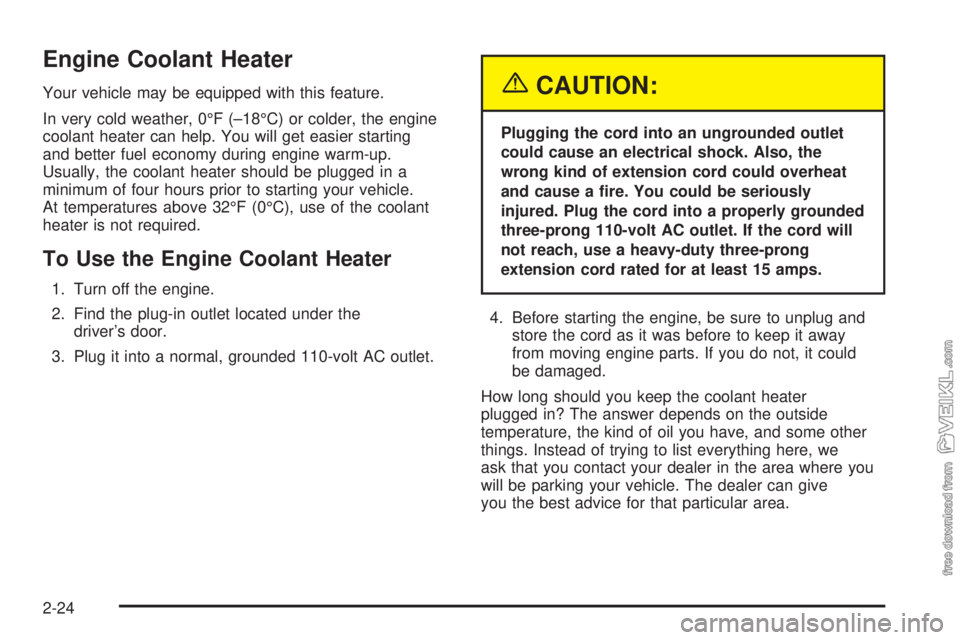
Engine Coolant Heater
Your vehicle may be equipped with this feature.
In very cold weather, 0°F (–18°C) or colder, the engine
coolant heater can help. You will get easier starting
and better fuel economy during engine warm-up.
Usually, the coolant heater should be plugged in a
minimum of four hours prior to starting your vehicle.
At temperatures above 32°F (0°C), use of the coolant
heater is not required.
To Use the Engine Coolant Heater
1. Turn off the engine.
2. Find the plug-in outlet located under the
driver’s door.
3. Plug it into a normal, grounded 110-volt AC outlet.
{CAUTION:
Plugging the cord into an ungrounded outlet
could cause an electrical shock. Also, the
wrong kind of extension cord could overheat
and cause a �re. You could be seriously
injured. Plug the cord into a properly grounded
three-prong 110-volt AC outlet. If the cord will
not reach, use a heavy-duty three-prong
extension cord rated for at least 15 amps.
4. Before starting the engine, be sure to unplug and
store the cord as it was before to keep it away
from moving engine parts. If you do not, it could
be damaged.
How long should you keep the coolant heater
plugged in? The answer depends on the outside
temperature, the kind of oil you have, and some other
things. Instead of trying to list everything here, we
ask that you contact your dealer in the area where you
will be parking your vehicle. The dealer can give
you the best advice for that particular area.
2-24
Page 91 of 374
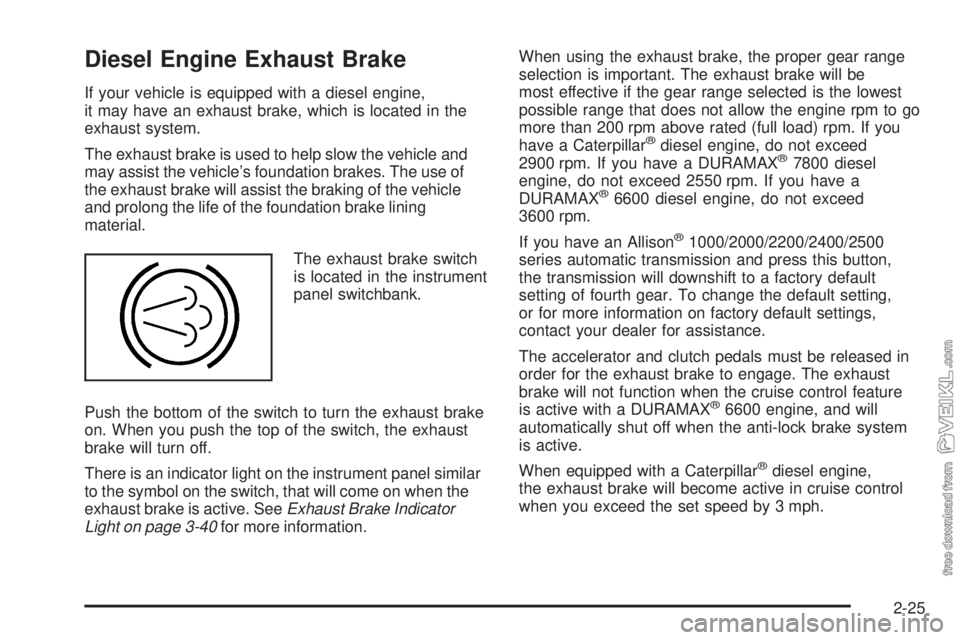
Diesel Engine Exhaust Brake
If your vehicle is equipped with a diesel engine,
it may have an exhaust brake, which is located in the
exhaust system.
The exhaust brake is used to help slow the vehicle and
may assist the vehicle’s foundation brakes. The use of
the exhaust brake will assist the braking of the vehicle
and prolong the life of the foundation brake lining
material.
The exhaust brake switch
is located in the instrument
panel switchbank.
Push the bottom of the switch to turn the exhaust brake
on. When you push the top of the switch, the exhaust
brake will turn off.
There is an indicator light on the instrument panel similar
to the symbol on the switch, that will come on when the
exhaust brake is active. SeeExhaust Brake Indicator
Light on page 3-40for more information.When using the exhaust brake, the proper gear range
selection is important. The exhaust brake will be
most effective if the gear range selected is the lowest
possible range that does not allow the engine rpm to go
more than 200 rpm above rated (full load) rpm. If you
have a Caterpillar
®diesel engine, do not exceed
2900 rpm. If you have a DURAMAX®7800 diesel
engine, do not exceed 2550 rpm. If you have a
DURAMAX
®6600 diesel engine, do not exceed
3600 rpm.
If you have an Allison
®1000/2000/2200/2400/2500
series automatic transmission and press this button,
the transmission will downshift to a factory default
setting of fourth gear. To change the default setting,
or for more information on factory default settings,
contact your dealer for assistance.
The accelerator and clutch pedals must be released in
order for the exhaust brake to engage. The exhaust
brake will not function when the cruise control feature
is active with a DURAMAX
®6600 engine, and will
automatically shut off when the anti-lock brake system
is active.
When equipped with a Caterpillar
®diesel engine,
the exhaust brake will become active in cruise control
when you exceed the set speed by 3 mph.
2-25
Page 92 of 374
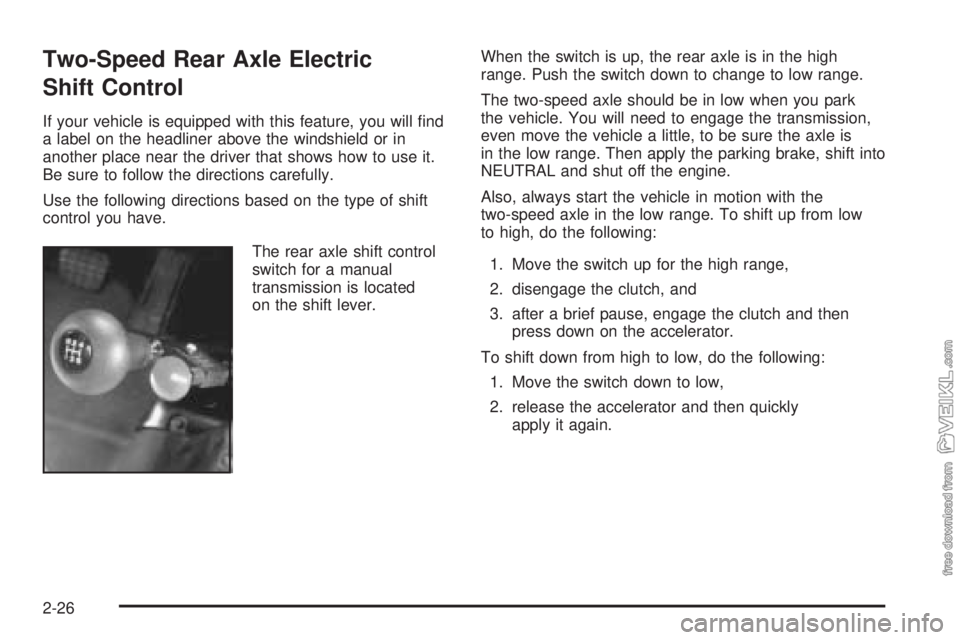
Two-Speed Rear Axle Electric
Shift Control
If your vehicle is equipped with this feature, you will find
a label on the headliner above the windshield or in
another place near the driver that shows how to use it.
Be sure to follow the directions carefully.
Use the following directions based on the type of shift
control you have.
The rear axle shift control
switch for a manual
transmission is located
on the shift lever.When the switch is up, the rear axle is in the high
range. Push the switch down to change to low range.
The two-speed axle should be in low when you park
the vehicle. You will need to engage the transmission,
even move the vehicle a little, to be sure the axle is
in the low range. Then apply the parking brake, shift into
NEUTRAL and shut off the engine.
Also, always start the vehicle in motion with the
two-speed axle in the low range. To shift up from low
to high, do the following:
1. Move the switch up for the high range,
2. disengage the clutch, and
3. after a brief pause, engage the clutch and then
press down on the accelerator.
To shift down from high to low, do the following:
1. Move the switch down to low,
2. release the accelerator and then quickly
apply it again.
2-26
Page 93 of 374
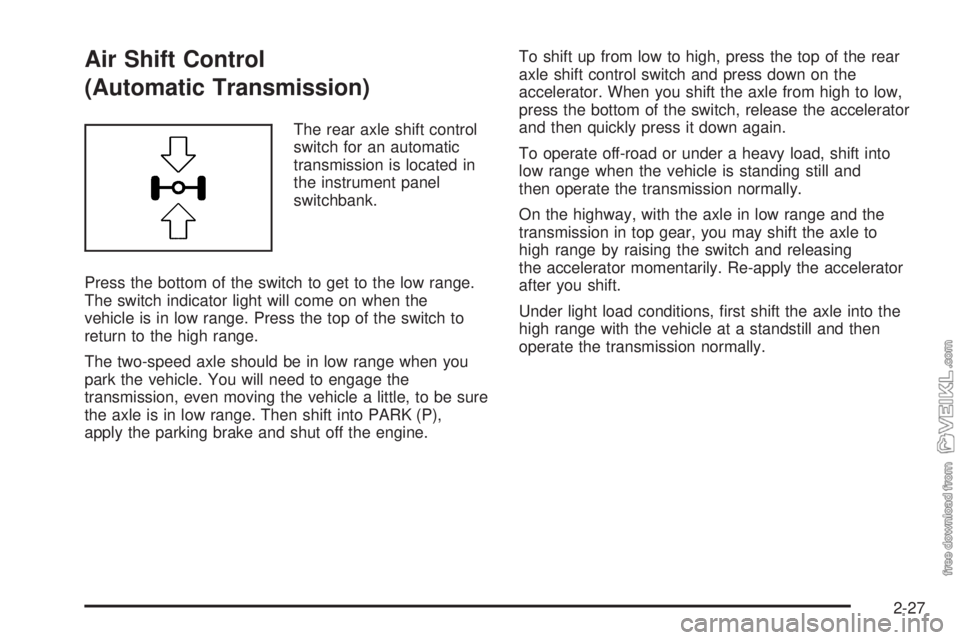
Air Shift Control
(Automatic Transmission)
The rear axle shift control
switch for an automatic
transmission is located in
the instrument panel
switchbank.
Press the bottom of the switch to get to the low range.
The switch indicator light will come on when the
vehicle is in low range. Press the top of the switch to
return to the high range.
The two-speed axle should be in low range when you
park the vehicle. You will need to engage the
transmission, even moving the vehicle a little, to be sure
the axle is in low range. Then shift into PARK (P),
apply the parking brake and shut off the engine.To shift up from low to high, press the top of the rear
axle shift control switch and press down on the
accelerator. When you shift the axle from high to low,
press the bottom of the switch, release the accelerator
and then quickly press it down again.
To operate off-road or under a heavy load, shift into
low range when the vehicle is standing still and
then operate the transmission normally.
On the highway, with the axle in low range and the
transmission in top gear, you may shift the axle to
high range by raising the switch and releasing
the accelerator momentarily. Re-apply the accelerator
after you shift.
Under light load conditions, first shift the axle into the
high range with the vehicle at a standstill and then
operate the transmission normally.
2-27
Page 94 of 374
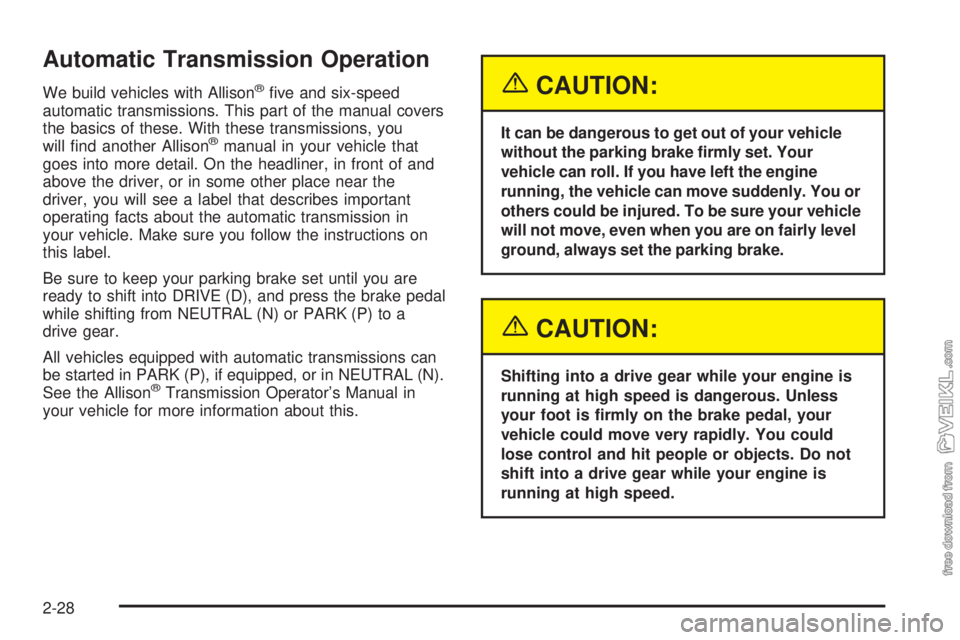
Automatic Transmission Operation
We build vehicles with Allison®five and six-speed
automatic transmissions. This part of the manual covers
the basics of these. With these transmissions, you
will find another Allison
®manual in your vehicle that
goes into more detail. On the headliner, in front of and
above the driver, or in some other place near the
driver, you will see a label that describes important
operating facts about the automatic transmission in
your vehicle. Make sure you follow the instructions on
this label.
Be sure to keep your parking brake set until you are
ready to shift into DRIVE (D), and press the brake pedal
while shifting from NEUTRAL (N) or PARK (P) to a
drive gear.
All vehicles equipped with automatic transmissions can
be started in PARK (P), if equipped, or in NEUTRAL (N).
See the Allison
®Transmission Operator’s Manual in
your vehicle for more information about this.
{CAUTION:
It can be dangerous to get out of your vehicle
without the parking brake �rmly set. Your
vehicle can roll. If you have left the engine
running, the vehicle can move suddenly. You or
others could be injured. To be sure your vehicle
will not move, even when you are on fairly level
ground, always set the parking brake.
{CAUTION:
Shifting into a drive gear while your engine is
running at high speed is dangerous. Unless
your foot is �rmly on the brake pedal, your
vehicle could move very rapidly. You could
lose control and hit people or objects. Do not
shift into a drive gear while your engine is
running at high speed.
2-28